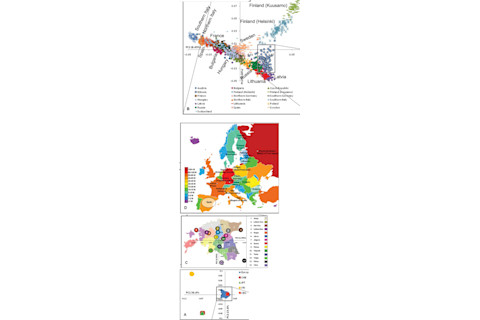A few months ago I relayed preliminary data which suggested that Estonians are not like Finns. Now a new paper, Genetic Structure of Europeans: A View from the North-East:
Using principal component (PC) analysis, we studied the genetic constitution of 3,112 individuals from Europe as portrayed by more than 270,000 single nucleotide polymorphisms (SNPs) genotyped with the Illumina Infinium platform. In cohorts where the sample size was >100, one hundred randomly chosen samples were used for analysis to minimize the sample size effect, resulting in a total of 1,564 samples. This analysis revealed that the genetic structure of the European population correlates closely with geography. The first two PCs highlight the genetic diversity corresponding to the northwest to southeast gradient and position the populations according to their approximate geographic origin. The resulting genetic map forms a triangular structure with a) Finland, b) the Baltic region, Poland and Western Russia, and c) Italy as its vertexes, and with d) Central- and Western Europe in its centre. ...When the PC analysis was confined to the 1,019 Estonian individuals (0.1% of the Estonian population), a fine structure emerged that correlated with the geography of individual counties. With at least two cohorts available from several countries, genetic substructures were investigated in Czech, Finnish, German, Estonian and Italian populations. Together with previously published data, our results allow the creation of a comprehensive European genetic map that will greatly facilitate inter-population genetic studies including genome wide association studies (GWAS).
Dienekes has posted some of the supplemental figures, which are of interest, but below I've reformatted the primary PC chart with further labels as well as some cutting & pasting to fit in the page width of this weblog:

It is noted in the text that the Kuusamo sample is from a population which settled the region 300 years ago and so was likely subject to a bottleneck, just like Iceland. The Russia sample is from Tver, a bit to the northwest of Moscow, so I'm a bit intrigued by its position in relation to the Baltic populations and the Poles. Specifically, historically Lithuania has been interposed between Poland and Russia, and from the 14th century onward Poland and Lithuania were politically united, ergo, the term "Poland-Lithuania." But after the official fusion of the Grand Duchy of Lithuania and Poland in 1569 the Lithuanian nobility was Polonized, so that the modern Lithuanian speaking nation are the descendants of the unassimilated peasantry whose identity crystallized in the wake of 19th century nationalist movements. As for the Russians, the current expanse of the Russian nation is due to a process of gradual demographic expansion from what is today Ukraine north and east. The existence of Finnic enclaves across northeast Russia is a testament to the dominance of these peoples before the Slavic expansion. In other words, the PC chart probably reflects a linguistic-geographic configuration extant before the year 1000. Despite the Russian expansion to the east, and their current encirclement of the Baltic and Finnic populations, the genetic data seem to hint at their previous relationship with Slavic groups to the West. Related:Genetic map of Europe; genes vary as a function of distance , Genetic Map of East Asia, The Genetic Map of Europe, More genetic maps of Europe, Finns as European genetic outliers, Population substructure in Japan, Finns as European outliers, The genetics of Fenno-Scandinavia, Korean genetic relationships and Human population structure, part n. Citation: Nelis M, Esko T, Mägi R, Zimprich F, Zimprich A, et al. (2009) Genetic Structure of Europeans: A View from the North-East. PLoS ONE 4(5): e5472. doi:10.1371/journal.pone.0005472













